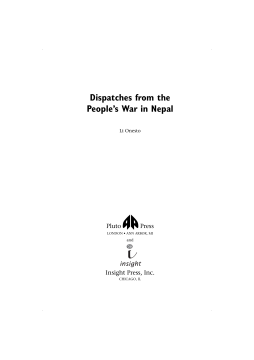
Additional Information
Book Details
Abstract
A Maoist revolution has been raging in Nepal since 1996. In 1999, Li Onesto became the first foreign journalist to travel deep into the guerrilla zones. Allowed unprecedented access, she interviewed political leaders, guerrilla fighters, villagers in areas under Maoist control, and relatives of those killed by government forces.
Millions in Nepal now live in areas under guerrilla control. Peasants are running grass-roots institutions, exercising what they call 'people's power'. Li Onesto describes these transformations -- the establishment of new governing committees and courts, the confiscation and re-division of land, new cultural and social practices, and the emergence of a new outlook.
Increasingly, the UK and US have directly intervened to provide political and military support to the counter-insurgency efforts of the Nepalese regime. Onesto analyzes this in the context of the broader international situation and the 'war on terrorism'.
'Invaluable background to the world's most vigorous Maoist movement, and insight into the theory and practice underlying contemporary Maoism elsewhere in South Asia and globally'
Gary Leupp, professor of history at Tufts University and Coordinator of the Asian Studies Program
'Probably the best, if not only, account of how the Maoists built their organisation and movement, and of how they operate and govern'
Stephen Mikesell, author of Class, State and Struggle in Nepal: Writings 1989-1995
'This is a lively, exciting and enlightening presentation of the true portrait of the Maoist insurgency in Nepal'
Padma Ratna Tuladhar, independent left leader, senior human rights leader and one of the facilitators in the peace talks between His Majesty’s Government of Nepal and the Communist Party of Nepal (Maoist)
Table of Contents
| Section Title | Page | Action | Price |
|---|---|---|---|
| Contents | 4 | ||
| Introduction | 1 | ||
| 1 Meeting the People's Army | 13 | ||
| 2 Villages of Resistance | 28 | ||
| 3 The Raid on Bethan | 34 | ||
| 4 Rifles and a Vision | 41 | ||
| 5 Revolutionary Work in the City | 47 | ||
| 6 General Strike in Kathmandu | 56 | ||
| Carrying the Story Forward: The Problem of Disinformation | 61 | ||
| 7 Land in the Middle | 66 | ||
| 8 Hope of the Hopeless in Gorkha | 74 | ||
| 9 Preparing the Ground in the West | 83 | ||
| 10 Learning Warfare by Waging Warfare in the West | 89 | ||
| Carrying the Story Forward: Revolutionary Policies | 121 | ||
| Photographs | 97 | ||
| 11 People's Power in Rolpa | 125 | ||
| 12 Guns, Drums, and Keyboards | 132 | ||
| 13 Teachers in a School of War | 137 | ||
| Carrying the Story Forward: Children in the War Zone | 144 | ||
| 14 Martyrs of Rolpa | 147 | ||
| 15 Families of Martyrs: Turning Grief into Strength | 154 | ||
| Carrying the Story Forward: The Rising Death Toll | 161 | ||
| 16 Women Warriors | 164 | ||
| 17 New Women, New People's Power | 172 | ||
| Carrying the Story Forward: The Fight for Women Leaders | 179 | ||
| 18 Magar Liberation | 183 | ||
| 19 Preparing for War in Rukum | 189 | ||
| 20 Starting and Sustaining People's War in Rukum | 194 | ||
| 21 Camping with the People's Army | 202 | ||
| 22 Red Salute in the West | 210 | ||
| Afterword | 219 | ||
| Notes | 233 | ||
| References | 241 | ||
| Index | 243 |
